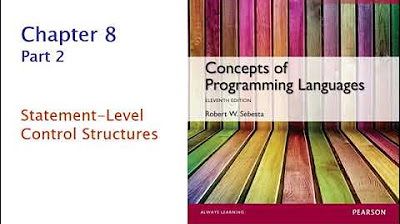Control statements
Summary
TLDRThis lecture introduces control statements in the C programming language, explaining how they enable decision-making and control program flow. It covers the concepts of simple 'if' and 'if-else' statements, demonstrating how conditions determine which code blocks execute. Through clear syntax explanations, flowchart illustrations, and practical examples—such as checking if a number is less than 10 or comparing two numbers to find the largest—the video helps learners understand conditional logic in C and how it directs the program’s execution based on true or false conditions.
Takeaways
- 😀 Control statements in C language help perform different sets of actions based on conditions.
- 😀 The primary types of control statements in C are the if statement, if-else statement, nested if statement, and switch statement.
- 😀 Control statements are often called 'decision-making statements' because they control the flow of execution based on conditions.
- 😀 A simple 'if' statement is used for a two-way decision based on a relational expression, executing a statement only if the condition is true.
- 😀 The relational expression in an 'if' statement evaluates to either true (non-zero) or false (zero), determining the flow of control.
- 😀 In a simple 'if' statement, only the true part is executed if the condition is true, and no action is taken if the condition is false.
- 😀 The 'if-else' statement extends the simple 'if' by adding a false block that is executed when the condition is false.
- 😀 In an 'if-else' statement, either the true block or the false block is executed, but not both.
- 😀 An example of using an 'if-else' statement is checking which of two numbers is larger and printing the result accordingly.
- 😀 C relational operators (such as ==, !=, <, >) are used in conditions to compare values and guide decision-making in control statements.
Q & A
What are control statements in C language?
-Control statements in C language are used to control the flow of execution depending on certain conditions. They allow programs to execute different actions based on specific conditions, and include statements like if, if-else, nested if, and switch.
What is the purpose of decision-making statements?
-Decision-making statements in C, such as if, if-else, and switch, help the program decide which set of actions to perform based on certain conditions. They change the flow of execution depending on whether the condition is true or false.
What is a simple if statement in C?
-A simple if statement evaluates a condition. If the condition is true, the associated statement(s) are executed. If the condition is false, no action is taken, and the program continues after the if block.
What happens when the condition in a simple if statement is true?
-When the condition in a simple if statement evaluates to true (i.e., non-zero), the statements within the if block are executed.
What happens if the condition in a simple if statement is false?
-If the condition in a simple if statement evaluates to false (i.e., zero), the program skips the if block and continues with the next part of the code after the if statement.
How does the if-else statement differ from the simple if statement?
-The if-else statement extends the functionality of the simple if by adding an else block. If the condition is true, the if block is executed; if the condition is false, the else block is executed.
What is the structure of an if-else statement?
-An if-else statement has a condition in parentheses, followed by a true block (if the condition is true) and a false block (if the condition is false). The true and false blocks contain the statements to be executed based on the evaluation of the condition.
Can both the true and false blocks in an if-else statement execute at the same time?
-No, only one block will execute based on the evaluation of the condition. If the condition is true, the true block is executed; if false, the false block is executed.
What is an example of using an if-else statement in C?
-An example is comparing two numbers to print the largest. If one number is greater than the other, it prints that number as the largest; otherwise, it prints the other number.
How are relational operators used in control statements in C?
-Relational operators like '==', '<', '>', '!=', and '<=' are used to compare two values in conditions. These operators help determine whether a condition is true or false, affecting the flow of execution in control statements.
Outlines

Dieser Bereich ist nur für Premium-Benutzer verfügbar. Bitte führen Sie ein Upgrade durch, um auf diesen Abschnitt zuzugreifen.
Upgrade durchführenMindmap

Dieser Bereich ist nur für Premium-Benutzer verfügbar. Bitte führen Sie ein Upgrade durch, um auf diesen Abschnitt zuzugreifen.
Upgrade durchführenKeywords

Dieser Bereich ist nur für Premium-Benutzer verfügbar. Bitte führen Sie ein Upgrade durch, um auf diesen Abschnitt zuzugreifen.
Upgrade durchführenHighlights

Dieser Bereich ist nur für Premium-Benutzer verfügbar. Bitte führen Sie ein Upgrade durch, um auf diesen Abschnitt zuzugreifen.
Upgrade durchführenTranscripts

Dieser Bereich ist nur für Premium-Benutzer verfügbar. Bitte führen Sie ein Upgrade durch, um auf diesen Abschnitt zuzugreifen.
Upgrade durchführenWeitere ähnliche Videos ansehen

MODUL IV PENYELEKSIAN KONDISI - PRAKTIKUM PENYELEKSIAN KONDISI

#2 How to change the flow of control through your code

Bahasa Pemrograman C #5 - Struktur Kontrol Keputusan - Informatika Kelas X

Minggu 3 - Eksekusi Kondisional

COS 333: Chapter 8, Part 2

Programming Basics: Statements & Functions: Crash Course Computer Science #12
5.0 / 5 (0 votes)
